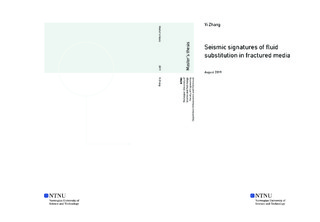| dc.description.abstract | Seismic response to the fluid substitution of oil with water and CO2 in a reservoir is analysed. A model consisting of horizontal layers based on the upscaling of well log data is studied. An interval of the model is selected as the reservoir background and then it is horizontally cracked. The model of alternating solid and fluid layers is employed. And the method of propagator matrix is applied to derive the slowness surfaces.
It has been found that there are 3 propagating modes in the horizontally cracked reservoir with fluid saturation, namely fast-P-, slow-P- and S-wave. Under seismic frequency (0-100 Hz), only fast-P-wave is weakly dispersive. The travel time analysis suggests that the overall P/fast-P-wave travel time is more sensitive to fluid substitution compared to that of S/slow-P-wave. And it is possible to identify fluid substitution from oil to CO2 through P/fast-P travel time when the fracture relative thickness phi = 0.001. Changing the period of the alternating layers H from 1 m to 5 m has no significant impact on the travel time. And it is almost impossible to detect fluid substitution through the travel time with such a low phi = 0.0001. Gradual replacement from oil to water results in an apparent ‘linear change’ to the P/fast-P travel time as a function of oil saturation.
To obtain P-fast-P-wave reflectivity from overburden to the reservoir, the reservoir is regarded as an effective VTI layer. For phi = 0.001, the reflectivity varies much from oil to CO2 saturation and the reflectivity change from oil to water is noticeable. H has only a tiny impact on the reflectivity. For lower phi = 0.0001 only the substitution from oil to CO2 is visible on R0 – R2 cross plot. The mixed-phase saturation for oil replaced by CO2 behaves like a linear effect to R0 – R2 as a function of oil saturation.
The seismic modelling of the acoustic wave equation by frequency-domain finite-difference method for the model with phi = 0.0001 yields the synthetic seismograms. And the result is consistent with the phenomenon mentioned above. The simulation for phi = 0.001 is suffered from high noise, thus, not displayed.
For comparison to the theory for porous media, Biot-Squirt poroelastic mechanism is also applied to the model background to make the reservoir background porous. The reservoir background with porosity phi = 0.001 is studied as an example. The result indicates that there is only a moderate reflectivity variation for the fluid substitution from oil to water/CO2. The travel time is almost the same with oil, water and CO2 saturation. | |
